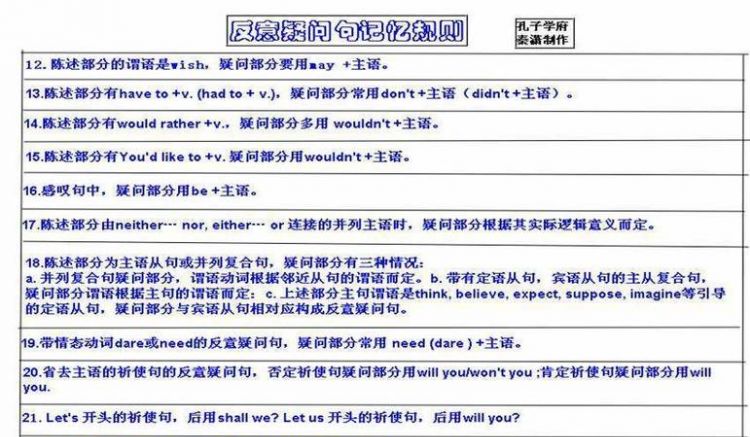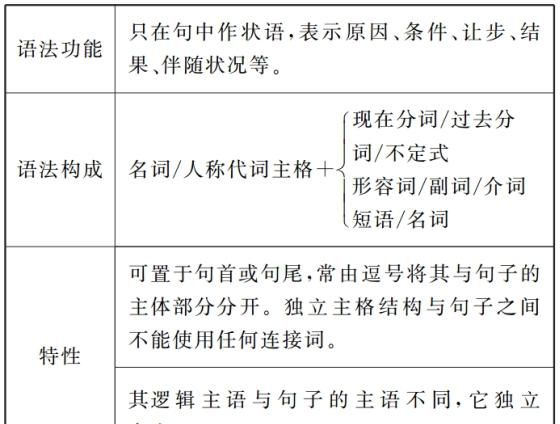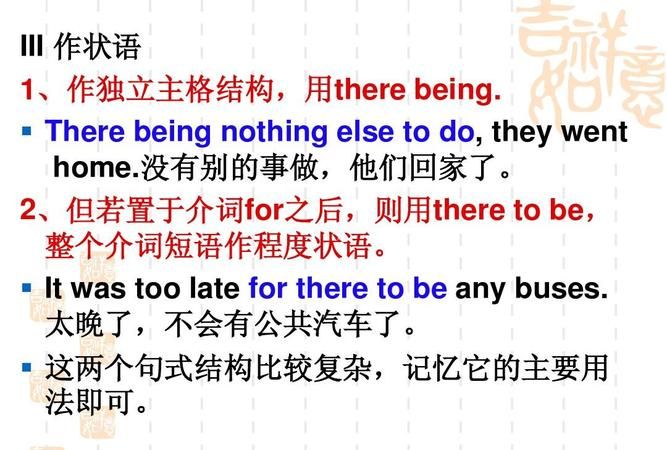本文目录
独立主格的用法
独立主格结构是一个独立主格的名词或代词(作为逻辑主格),加上一个分词、形容词、副词、不定式、介词短语。其作用相当于状语,多用来表示行为、方式或伴随的情况,有时也用来表示时间和条件。这种结构多用在书面语中。
一、几种常见的独立主格结构形式
1.名词(或代词)+现在分词(或过去分词)。如:
1)The moon appearing,they decided to go on with theirjouney.
2)Good-bye said,he went home.
2.名词(或代词)+形容词。如:
3)The weather(being)hot,we all went swimming.
3.名词(或代词)+不定式。如:
4)Some of the money to be paid by the thief, the policewent.
4.名词(或代词)+介词短语。如:
5)He climbed in,sword in hand.
5.名词(或代词)+副词。如:
6)The meeting(being)over, we left the room.
独立主格结构的模式是:
主格名词/代词 + 分词/形容词/副词/不定式/介词短语
(作逻辑主语) (作逻辑谓语)
1. All our savings gone, we started looking for jobs.
2. The question settled, we went home.
3. The river having risen in the night, the crossing was impossible.
主格名词/代词 + 分词 (过去分词/现在分词)
主格名词/代词 + 形容词
1. His mother being ill, he had to stay home to look after her.
2. Other things being equal, I would buy the black dress.
主格名词/代词 + 副词
The meeting being over, our headmaster soon left
the meeting-room.
We to care for the children, you are able to be carefree
away from home.
主格名词/代词 + 不定式
主格名词/代词 +介词短语
Our English teacher came into the classroom, papers in hand.
with复合结构 与 独立主格结构
它们都可以在句中作原因状语,伴随状况状语,条件状语,时间状语或结果状语用,一般也可以相互转换.虽然它们的语法功能和意义相同,但其结构形式和名称却不相同.
with复合结构的模式是:
with+名词/代词+分词/形容词/副词/不定式/介词短语
独立主格结构的模式是:
主格名词/代词+分词/形容词/副词/不定式/介词短语
一,作时间状语
1,With winter coming on, the trees turn yellow and
some birds fly south.
=Winter coming on, the trees turn yellow and some
birds fly south.
二,作原因状语
1,With the weather terribly cold, we entered the
room to warm ourselves.
= The weather terribly cold, we entered the room to warm ourselves.
2,With the key having been lost, she could not
enter the room.
= The key having been lost, she could not enter the room.
三,作条件状语
1,With time permitting, we'll visit the Summer Palace.
= Time permitting, we'll visit the Summer Palace.
2,With the car going wrong, we'll have to stop
at the foot of the mountain.
= The car going wrong, we'll have to stop at the foot
of the mountain.
四,作伴随状语
1,The mother was cleaning the house with her baby
playing on the bed.
=The mother was cleaning the house, her baby playing
on the bed.
2,Last night I followed him, with a sword in my hand.
= Last night I followed him , sword in hand.
无论with复合结构还是独立主格结构,都不可有动词的谓语形式充当其中的逻辑谓语.如下例中的was就必须去掉:
He sat at the desk reading
with a pen was in his right hand.
with复合结构可以作后置定语修饰名词,而独立主格结构则不可作后置定语修饰名词.
Soon she arrived at a park with grass green and
flowers in blossom.
= Soon she arrived at a park whose grass was green
and whose flowers were in blossom.

英语中独立主格的用法
独立主格结构是由一个相当于主语的名词或代词加上非谓语动词、形容词(副)词、或介词短语构成的一种独立成分。该结构不是句子,也不是从句,所以它内部的动词不能考虑其时态、人称和数的变化,它与其主句之间既不能通过并列连词连接也不能有从句引导词引导,常用逗号与其主句隔开。独立主格结构在很多情况下可以转化为相应的状语从句或其他状语形式,但很多时候不能转化为分词形式,因为它内部动词的逻辑主语与主句主语不一致。在做这类题目时一定要小心判断,不能粗心大意。
一、独立主格结构的构成形式
独立主格结构的构成方式为:名词普通格或代词主格+现在分词/过去分词/不定式/名词/形容词/副词/介词短语等。使用独立主格结构是因为出现了与句子主语不一致的情况。
1. 名词或代词+现在分词
现在分词表示前面的名词或代词主动进行的动作或状态。如:
The man lay there, his hands trembling.
那个男子躺在那儿,双手在颤抖。
有时,现在分词being或having been在独立主格结构中可以省略。如:
The weather (being) fine,we decided to go swimming.
天气晴朗,我们决定去游泳。
2. 名词或代词+过去分词
过去分词表示前面的名词或代词被动完成的动作。如:
The girl sat there silent,her head bent low.
这姑娘一声不响,低着头坐在那里。
All things considered, her paper is of greater value than yours.
各方面考虑起来,她的论文比你的论文更要有价值一些。
3. 名词或代词+不定式(短语)
不定式表示将来的动作。如:
He suggested going for a picnic,Mary to provide the food.
他建议去野餐,由玛丽负责提供食物。
Time is pressing, two hours to go only.
时间紧迫,只剩两个小时了。
4. 名词或代词+名词(短语) 如:
Many people joined in the work, some of them women and children.
许多人参加了这项工作,其中一些人是妇女和儿童。
5. 名词或代词+形容词(短语)
形容词(短语)说明前面名词或代词的性质或状态。如:
The floor wet, we had to stay outside for a while.
地面很湿,我们只好在外面呆一会儿。
6. 名词或代词+副词
副词也多是说明前面名词或代词的状态。如:
The meeting over, we all went home.
会议结束了,我们都回家了。
7. 名词或代词+介词短语 如:
The teacher came in, a book in his hand.
老师进来了,手里拿着一本书。
有时,独立主格结构中名词前面的定语可以省略。如:
The boy lay silently on the grass, (his) eyes closed.
A girl was walking in the street, (a) flower in (her) hand.
二 独立主格结构的作用
1. 作状语
1) 表示时间 如:
Her homework done (=After her homework was done),Lucy decided to go shopping.
2) 表示原因 如:
There being no buses (Because there were no buses),we had to walk home.
3) 表示条件 如:
Weather permitting (If weather permits), we will go to play football.
4) 表示方式或伴随 如:
He rushed into the room, his face covered with sweat.
2. 作同位语 如:
There are two doors, one leading to the bedroom, the other (leading) to the kitchen.
三 独立主格前面有时可以加上介词with或without,构成介词的复合结构。这种结构在句中主要用作状语,也可用作定语。如:
He stood on the deck with his hand waving to us.(状语)
他站在甲板上向我们频频挥手。
He went out without a hat on his head.(状语)
他头上没戴帽子就出去了。
Do you know the girl with a bag on her back?(定语)
你认识那个后背上背包的女孩吗?

如何区分定冠词,不定冠词和零冠词用法
零冠词用法归纳
1. 用于复数名词前
复数名词泛指某类人或物时,其前通常用零冠词。如:
Students should obey the school rules. 学生应该遵守校规。
Trees don’t grow in the Antarctic. 南极不长树木。
【说明】复数名词若需特指,则要加定冠词。如:
The students are too lazy. 这些学生太懒。
2. 用于不可数名词前
不可数名词表示泛指时,其前通常用零冠词。如:
Bread is made from flour. 面包是用面粉做的。
Wood is a poor conductor of sound. 木头是声音的不良导体。
【说明】不可数名词若需特指,则要加定冠词。如:
He sawed the wood into three pieces. 他把木头锯成三块。
3. 用于专有名词前
在通常情况下,专有名词前要用零冠词。如:
Mr Smith is our English teaches us English. 史密斯先生教我们英语。
【说明】在特殊情况下,若专有名词需要特指,也可加定冠词。如:
The Smith you’re looking for no longer lives here. 你找的那个史密斯不再住这里。
4. 用于某些单数可数名词前
单数可数名词前在某些特殊情况下用零冠词,如用作呼语时、表示家庭成员时、用于表示“变成”的连系动词 turn, go 之后作表语时、用于倒装的让步状语从句中时等。如:
Can I tell Father about it? 这事我可以告诉爸爸吗?
He was a teacher before he turned writer. 在成为作家前他是教师。
Child as he was, he did quite well. 虽然是孩子,但他做得很不错。
【说明】用于某些独立结构中的单数可数名词也通常用零冠词。如:
Suddenly a man came in, knife in hand. 突然进来一个人,手里拿着刀。
另外,在 kind [sort] of 后接单数可数名词时也通常用零冠词。如:
He is too young for that kind of job. 他太年轻,不能干那种工作。
5. 用于抽象化的可数名词前
有些可数名词抽象化后表示表示的活动,其前通常零冠词。如
Jim has gone to bed. 吉姆已上床睡觉了。
She goes to church every Sunday. 她每周星期天都去做礼拜。
【说明】这类主要涉及bed, church, class, college, school, university, work, hospital, prison, market, sea, town等。另外,这类名词前用不用冠词有时与英美英语的表达习惯有关。如:“住院”在英国英语中通常说成 in hospital,而在美国英语中则通常说成in the hospital;类似的还有go to university (英)上大学 / go to the university (美)上大学;at table (英)在吃饭 / at the table (美)在吃饭。
6. 用于职务及头衔前
当表示职务及头衔的名词用作表语、补足语及同位语时,其前通常用零冠词。如:
Wilson became President of the U. S. A. 威尔逊当了美国总统。
He will be made captain of the football team. 他将被选为足球队队长。
【说明】有时也可用定冠词,但以不用为多见
7. 用于球类运动前
Let’s go and play basketball. 我们去打篮球吧。
You can’t pick the ball up in football. 踢足球时不许用手持球。
【说明】若指球类运动,其前用零冠词;若球类运动所用的球,则根据情况可用冠词。如:
The basketball cost me 30 yuan. 这个篮球花了我30元。
8. 其他用零冠词的场合
按英语习惯,在表示学科、语言、三餐、月份、季节、节假日、星期等名词前,通常用零冠词。如:
We are all interested in physics. 我们大家都对物理感兴趣。
Won’t you stay and take lunch with us? 留在这儿吃午饭好吗?
School begins in September. 九月开学。
It’s a fortnight to National Day. 离国庆节还有两星期。
She has been here since Monday. 从礼拜一起她一直在这里。
8. 用于某些固定结构中
go to sea 去当水手 at home 在家
at night 在晚上 at least 至少
at most 至多 at first 首先
at last 最后 in bed 在床上
on foot 步行 face to face 面对面
定冠词用法归纳
1. 表示特指
定冠词表示特指,既可特指上文提到过的人或事物,也可特指谈话双方都清楚的人或事物,还可特指受后置定语或定语从句修饰的人或事物。如:
Where’s the teacher? 老师在哪儿?
There I met a foreigner and the foreigner helped me a great deal. 在那儿我遇到一个老外,这个老外帮了我不少忙。
The manager you want to see was here just now. 你要见的那位经理刚刚还在这里。
2. 表示类别
(1) 概括整个类属:定冠词与单数可数名词连用可以概括整个类属,有时还可以与某些形容词连用表示整个属。如:
The computer is a great invention. 计算机是一项伟大的发明。
The young should respect the old. 年轻人应该尊敬老年人。
The English are famous for liking tea. 英国人以喜欢喝茶出名。
【说明】不定冠词和定冠词均可连用单数可数名词表示类别,但前者通常强调个体,起泛指作用,其用法相当于any;后者既可强调个体(可与不定冠词互换),也可强调整体(不可与不定冠词互换)。如:
The monkey is a clever animal. = A monkey is a clever animal. 猴是一种聪明的动物。(句中既可用不定冠词也可用定冠词,因为它表示泛指意义)
The tiger is in danger of becoming extinct. 老虎有绝种的危险。(此句用定冠词概括整个类属,不能换成不定冠词)
(2) 与某些形容词连用,表示一类人或一类事物。如:
the rich 富人 the poor 穷人 the wealthy 富人
the old 老人 the aged 老人 the young 年轻人
the sick 病人 the brave 勇敢的人 the weak 弱者
the strong 强者 the dead 死者 the blind 盲人
the dumb 哑巴 the deaf 聋子 the wounded 伤员
the injured 伤员 the impossible 不可能的事
the unknown 未知世界
3. 表示世上独一无二的事物
这里说的世上独一无二的事物主要指the sun, the moon, the earth, the sky, the universe, the world, the atomosphere(大气层)等东西。如:
The sun rises in the east and sets in the west. 太阳从东方起,西方落下。
【说明】若这类名词前有形容词修饰,表示具有某种特征,则也可能将定冠词改为不定冠词,如 a full moon(满月),a friendly world(友好的世界)等。
4. 连用序数词和最高级
序数词和形容词最高级前通常要用定冠词,副词最高级前可用定冠词,也可不用。如:
It was the best result they’ve ever had. 这是他们历来取得的最好成绩。
He won the first game and I won the second, so we’re even. 他赢了第一局的比赛,我赢了第二局,因此我们打平了。
【说明】当序数词表示名次时,其前的定冠词通常可以省略。如:
Who won (the) first prize? 谁获得了一等奖?
另外,当序数词不是表示顺序,而是表示“另一个”时,则在其前用不定冠词。如:
I want to read it a second time. 我想再看一次.
5. 用于某些专有名词前
如用于河流、海洋、山川、海岛、海峡、沙漠等专有名词前,以及用于由普通名词构成(或含有普通名词)的专有名词如国名、地名、团体、机构、党派、报纸、杂志、事件、建筑物等前。如:
the Yellow River 黄河 the Red Sea 红海
the Indian Ocean 印度洋 the Taiwan Straits 台湾海峡
the Sahara (Desert) 撒哈拉大沙漠 the United States 美国
the Times 泰晤士报 the Great Wall长城
the Great Cultural Revolution 文化大革命
注:表示湖泊的专有名词前通常不加定冠词,但对于中国的湖泊则习惯上要加定冠词,如 the Dongting Lake(洞庭湖)。
6. 用于乐器名词前
当乐器名词表示演奏时,其前通常要用定冠词。如:
She likes playing the piano. 她喜欢弹钢琴。
The girl practices the violin every day. 这女孩每天练习拉小提琴。
注:若乐器名词不是表示演奏,而是表示乐器的实物,则不一定用定冠词。如:
These two pianos are very cheap. 这两架钢琴很便宜。
7. 用于姓氏的复数之前
定冠词有时可用于表示姓氏的复数前,表示全家人或全家中两个或两个以上的人。如:
None of us here like the Smiths. 我们这里没有人喜欢史密斯一家人。
The Greens were too poor to send their son to school. 格林夫妇太穷,没钱送他们的儿子上学。
8. 用于逢整十数词的复数前
定冠词有时可用于逢整十的复数数词前,表示世纪中的年代。如:
He moved to the south in the fifties. 他于50年代搬到了南方。
The war broke out in the 1980s. 战争爆发于20世纪80年代。
9. 用在某些习惯用语中
at the same time 同时 by the way 顺便问一句
for the present 暂时 go to the cinema 看电影
in the end 最后 in the dark 在黑暗中,不知道
in the least 一点,丝毫 in the open 在野外
in the past 在过去 in the long run从长远来看
in the event of 万一 in the morning 在上午
in the way 挡道,碍事 on the whole总体上
on the other hand 另一方面 on the contrary相反地
out of the question不可能的
不定冠词用法归纳
1. 表示泛指
不定冠词表示泛指,既可指同类中的任何一个(与 any 同义),也可指同类中的某一个。如:
A square has four sides. 正方形有四条边。
I met an old man at the gate. 我在门口遇到一位老人。
2. 表示数量“一”
不定冠词可以表示数量“一”,但其数的概念不如one 强烈。如:
Give me an apple. 给我一个苹果。(重点在 apple,即不要梨、桔等)
Give me one apple. 给我一个苹果。(重点在 one,即不要两个或三个)
3. 表示“相同的”
表示“相同的”,与 the same 同义,尤其与介词 of 一起使用。如:
The children are all of an age. 这些孩子都是同年的。
Birds of a feather flock together. 物以类聚。
4. 表示“每一个”
与 every, each, per 同义,尤其用于表示价格、速度、比率等。如:
I visit my grandmother once a month. 我每月看我奶奶一次。
He makes $1,000 a month. 他每月挣 1,000 元。
5. 表示“某一”
与 a certain 同义。如:
In a sense you are right. 在某种意义上你是对的。
A Mr. Brown wishes to see you. 一位叫布朗的先生想见你。
6. 表示“像……似的”
与 one like 同义。如:
He is also a Lei Feng in our class. 他也是我们班的一个雷锋式的人物。
7. 用于某些习惯用语中
不定冠词用于习语的情形很普遍,如:
a lot of 许多 a little 有点儿 a number of 许多
as a result 因此 as a rule 通常 as a whole 总体上说
have a rest 休息 have a cold 患感冒 have a good time 过得开心
in a way 在某种程度上 in a hurry 匆忙 in a word 总之
make a living 谋生

加定冠词和加零冠词意思不同的词组有哪些
at (/) table 在进餐 at the table 在桌子旁边 at (/) desk 在读书 at the desk 在课桌旁 at (/) school 在上学 at the school 在学校里 in (/) class 在上课 in the class 在班级里面 in (/) bed 卧床 in the bed 在床上 in (/) prison 坐牢 in the prison (因事)在监狱 in (/) hospital 住院 in the hospital (因事)在医院 go to (/) school 去上学 go to the school (因事)去学校 go to (/) bed 上床睡觉 go to the bed (因事)在床上 go to (/) hospital 去看病 go to the hospital (因事)去医院 二. take (/) place 发生 take the place 代替 in (/) place of 代替 in the place of 在...的地方 in (/) case of 万一 in the case of 就...来说 out of (/) question 毫无疑问(100%) out of the question 完全不可能 (0%) 通常使用不定冠词的短语 after a while 过了一会儿 all of a sudden 突然 as a rule 通常 as a result 结果,因此 as a matter of fact 事实上 as a whole 大体上 at a loss 不知所措 in a hurry 急忙 in a way 在某种程度上 in a word 总而言之 It’s a pity that… 令人遗憾的是… put an end to… 结束… come to an end 结束 come to a conclusion 得出结论 have a good time 玩得愉快 have a rest 休息一下 have a cold 感冒 have a word with 和…谈一谈 keep an eye for 对…有鉴赏力 make a living 谋生 make a fire 生火 make a fool of 愚弄 take a walk 散步
不定冠词巧记
a与an两种体,不重数量相当“一”可数名词首次提,有时还可表“每一个” 不定冠词有"a和an"两种形式。"a"用在以辅音音素开头的词前,而不是辅音字母前;"an"用在以元音音素开头的词前,而不是元音字母前,(例如hour,第一个元音是“а”,故用an。当字母单独出现时A E F H I L M N O R S X 也要使用不定冠词"an",其次特别要注意的是 U 这个字母单独出现发的并不是元音 同理 UNIVERSITY USUAL也都不用不定冠词"an”。但UNCLE要用“an”)。确定用“a”还是“an”,有一个口诀:不见“原因(元音)”别施“恩(n)”。 这a和an的区别是:a用于辅音音素开头的单词之前,an用于元音音素开头的单词之前。
用法
1.表示泛指,指某类人或事物中的“一个”。 以元音音素开头单词前用不定冠词an。 例:Can you lend me an umbrella? 你能借我一把雨伞吗? 以辅音音素开头的单词前用不定冠词a。 例:His mother is a nurse. 他妈妈是一名护士。 Give me a ruler, please. 请给我一把尺子。 2.表示人或物的某一种类,强调整体,即以其中的一个代表一类 例:A horse runs faster than an elephant. 马比大象跑得快。 3.指某人或某物(不是指某一类),但不具体说明何人或何物(一般译为“一”)。 例:A girl is looking for you. 有个女孩正在找你。 4.表示数量,有“一”的意思,但数的概念没有One强烈(一般译为“一”) 例:I have a mouth, a nose and two eyes. 我有一张嘴,一个鼻子和两只眼睛。 Wait a minute. 等一下 5.表示单位,相当于“每”的意思 例:We have six classes a day. 我们每天有六节课 He goes to the Book City four times a(=every) month. 他一个月去四次书城 6.用在固定搭配中。 例:a lot of, a little of, a few,a bit等
省略用法
1.在不引起误会的情况下,两个并列名词中的后一个名词前的不定冠词可以省略:The noun is the name of a person or thing. 名词是人和物的名称。 2. 当两个并列名词指的是同一个人时,后一名词前的不定冠词通常省略: His father is a teacher and poet. 他父亲是位教师兼诗人。 但如果要强调这两种身份,也可后一个不定冠词: His father is a teacher and a poet. 他父亲既是教师,又是诗人。 有时,由于两个并列的名词关系比较紧密、被视为一个整体,也可只用一个冠词: A man and woman are walking arm-in-arm. 一对男女手挽着手走着。 3. 两个形容词并列同时修饰一个名词时,若该名词指的是两个事物,则通常应分别使用两个冠词: We have a black and a white cat. 我们养了一只黑猫和一只白猫。 (比较:We have a black and white cat. 我们养了一只黑白花猫。) 但是,有时两个并列的名词只一个事物,为了加强语气,也有了两个冠词: It was a cold and a dark night. 那是一个又冷又黑的夜晚。 4. 有些由两样东西构成的“自然成对”使用的事物,通常只在其前使用一个冠词: a knife and fork 一副刀叉 a cup and saucer 一副茶杯与茶托 a horse and cart 一辆马车 a needle and thread 一根带线的针 hire a car and driver 租一辆配有司机的汽车 有时连第一个冠词也省略(尤其是与介词连用时):with knife and fork 用刀叉 5. 当要对两个并列的名词进行选择和比较方面的强调时,通常应重复两个冠词: Give me a pen,not a pencil. 给我一支钢笔,不是铅笔。 Do you want a novel or a dictionary? 你是想要本小说,还是想要本字典?
备注
用于习惯用语中。 all of a sudden 突然as a result 结果 a little 一点;一些 a bit 一点 a great many=a very large number of 许多;大量 a great deal(of...) 许多 a lot(of...)许多 have- a cold 感冒 have a good(nice,wonderful,great)time 玩得高兴 pay a visit 拜访
编辑本段定冠词的用法
巧计定冠词the用法歌诀: 特指双方熟悉,上文已经提起。 世上独一无二,方位名词乐器。 某些专有名词,还有复数姓氏。 序数词最高级,习惯用语牢记。 1. 用以特指某(些)人或某(些)事物 This is the house where Luxun once lived. 这是鲁迅曾经住过的房子。 2. 用于指谈话双方都明确所指的人或事物 Open the door,please. 请把门打开。 3. 用以复述上文提过的人或事物(第一次提到用“a或an”,以后再次提到用“the”) Once there lived a lion in the forest. Every day the lion asked small animals to look for food for him. 从前森林里住着一只狮子。每天这只狮子要小动物们为他寻找食物。 4. 用在序数词和形容词最高级前。 January is the first month of the year. 一月份是一年当中的第一个月。 He is always the first to come and the last to leave. 他总是第一个来最后一个离开。 Shanghai is the biggest city in China. 上海是中国最大的城市。 5. 表示地球、宇宙等独一无二的事物 the sun 太阳 the moon 月亮 the earth 地球 the sky 天空 the world 世界 6. 指由普通名词构成的专有名词 the West Lake 西湖the Great Wall 长城 the United States 美国the United Nations 联合国 the Browns 布朗一家 the English 英国人 the WTO 世界贸易组织 7. 用于表示地点、方位、具体的时间或某天的一部分等。 in the east 在东方 in the west 在西方 in the front 在前面 at the back 在后面 in the bottom 在底部 at the top 在顶部 on the right 在右边 on the left 在左边 8. 在海洋、江河、湖泊、山脉、海峡、海湾等地理名词前 the Pacific Ocean 太平洋the Huanghe River 黄河 the Tianshan Mountains 天山山脉the Taiwan Straits 台湾海峡 注:孤山等前不加the。 9. 在姓氏复数前,表示一家人 The Bakers came to see me yesterday. 贝克一家人昨天来看我。 10. 和某些形容词连用,使形容词名词化,代表一类人或物 the poor 穷人 the rich 富人 the sick 病人 the wounded 伤员 the good 好人 the beautiful 美丽的事物 11. 用在表示阶级、政党的名词前 the working class 工人阶级 the Chinese Communist Party 中国共产党 12. 用在the very强调句中 This is the very book I want. 这就是我想要的那本书。 13. 在the more,the more比较级的句式中 The more you drink,the more you like it. 你越喝就越爱喝。 14. 用于西洋乐器前(民族乐器前不加) play the piano 弹钢琴 play the violin 拉小提琴 *中国乐器名词前不与冠词连用:play erhu(二胡)] the+n{发明物} 必须是单数 who invented the telephone 15. 某些固定的表达法 in the morning 在早上 in the afternoon 在下午 in the evening 在晚上 go to the cinema 去看电影 go to the theatre 去看戏 all the year round 一年到头 on the way to 前往...去的路上 16. the加单数可数名词可以表示一类人或事物 The horse is a useful animal. 马是一种有用的动物。 注意:像这类句子还有如下两种写法 A horse is a useful animal. Horses are useful animals. 17.在句型“动词+sb.+介词+the+身体某一部位”中要用 the,而不 用人称代词。 take sb. by the arm 抓住某人的手臂 hit sb. in the face 打某人的脸 be red in the face 脸红 be lame in the right leg 右腿瘸 等结构中,名词前要用the 18 用在世纪或逢十{1990}的复数名词前 in the18th century 在18世纪 in the 1960s 在20世纪60年代 19 多与民族 国籍的形容词连用 the chinese are brave hard-working people 中国人是勤劳和勇敢的人 20 用于报刊 杂志 会议 条义 历史 时期 朝代的名词前 the Xian incident 西安事变
编辑本段零冠词的用法
1. 专有名词、物质名词、抽象名词前一般不加冠词(在特指时加冠词) (/)China 中国 (/)Europe 欧洲(/)Money 金钱(/)Music 音乐 (/)Lei Feng 雷锋(/)William Shakespeare 威廉·莎士比亚 2. 月份、星期、节日 前一般不加冠词(在特指时加冠词) (/)January 一月份 (/)Sunday 星期日 (/)Christmas Day 圣诞节 (/)Thanksgiving 感恩节 (/)National Day 国庆节 (/)May Day 劳动节 比较:...on a Sunday morning. 在一个星期天的早晨... (表示某一个。) 注:民族节日前要加the 如:the Spring Festival 3. 三餐、四季前一般不加冠词 I have (/)lunch at (/)school. 我在学校吃午餐。 (/)Summer is the best season for swimming. 夏天是游泳的好季节。 比较:I had a big lunch yesterday. 昨天我吃了一顿丰盛的午餐。(表示某一个) The dinner given by Mr Smith was very nice. 史密斯先生款待的晚宴真是美味。(表示特指) 比较:I will never forget the summer we spent in Hawaii. 我永远不会忘记我们一起在夏威夷度过的那个夏天。 (表示特指) 4. 进行球类运动 play (/) basketball 打篮球 play (/) volleyball 打排球 play (/) football 踢足球 5. 没有特指的物质名词 This cart is made of (/) wood. 这辆手推车是用木头作的。 比较:The wood outside was all wet. 外面的那些木头都湿了。(表示特指) 6. 没有特指的不可数抽象名词 (/) Time is precious. 时间是宝贵的。 比较:The time of the play was 1990s. 这个剧本的时代背景是二十世纪九十年代。(表示特指) 7. 没有特指的可数名词复数形式后。 I like (/) tomatoes. 我喜欢西红柿。 8. 山峰 (/) Mount Qomolangma 珠穆朗玛峰 9. 固定词组 go to (/) school 去上学 go to (/)bed 上床睡觉 go by (/) train 乘火车去 go by (/) boat 乘船去 at (/) table 在用餐 in (/) hospital 住院 at (/) school 求学 in (/)school 求学 at (/) noon 在中午 at (/) night 在晚上 at (/) midnight 在半夜 in (/) town 在城里 10. 独立结构中的名词不加冠词 A boy came in,(/) book in hand. 一个男孩进来,手上拿着书。 11. 泛指人类 (/) Man is mortal. 人必有一死。 12. 在"kind of+名词 sort of+名词"句式中 What (/) kind of (/) flower is it 这是什么花? I like this sort of (/)book. 我喜欢这种书。 13. 指职位、头衔的词,如king,captain,president,chairman ,leader等。 He is (/或the) captain of the team. 他是球队的队长。 As (/或the) chairman of the committee,I declare the meeting open. 作为委员会主席,我宣布会议开始。 比较:The Captain of Morritius (荷兰殖民时期)毛里求斯首长 冠词和三餐的搭配 三餐名词单独使用时,之前通常不加冠词 三餐名词之前若加形容词时则除外: We have (/) breakfast at eight. 我们8点钟吃早饭。 He gave us a good breakfast. 他请我们吃了一顿丰盛的早餐。 I was invited to (/) dinner. 他们邀请我吃饭。 I was invited to a dinner given to welcome the new ambassador. 我被邀请参加欢迎新任大使的宴会。 The Scots have (/) porridge for breakfast. 苏格兰人早餐吃粥。 The wedding breakfast was held in her father’s house. 婚礼早宴是在她父亲家举行的。 零冠词用法归纳: 独一职位在某地,用作表/补/同位语;独立主格作状语,用by短语表方式;man字一词指人类, 对比含义两名词;系词turn+名单数,街/路/期刊与杂志;具体意义变抽象,as/though之倒装句; 人名/地名/国一词,抽象/物质不特指;桥名/单岛/单山峰,一专加一普专用词;月份/星期/节假日, 学科/语言/称呼语;颜色/病名/五感觉,棋类/球类/三餐词;复数名词系泛指,固定词组惯用语; 以上情况请记住,其前均用零冠词。
1) 不定冠词位置 不定冠词常位于名词或名词修饰语前。注意: a. 位于下列形容词之后:such,what,many,half, I have never seen such an animal. Many a man is fit for the job. b. 当名词前的形容词被副词as,so,too,how,however,enough修饰时,不定冠词应放在形容词之后: It is as pleasant a day as I have ever spent. So short a time. Too long a distance. c. quite,rather与单数名词连用,冠词放在其后。 但当rather,quite 前仍有形容词,不定冠词放其前后均可。如:quite a lot d. 在as,though 引导的让步状语从句中,当标语为形容词修饰的名词时,不定冠词放形容词后: Brave a man though he is,he trembles at the sight of snakes. 他尽管勇敢,可见到蛇还是发抖。 当名词被比较级形容词修饰时,不定冠词通常置于比较级形容词之后。 2) 定冠词位置 定冠词通常位于名词或名词修饰语前,但放在all, both,double,half,twice,three times等词之后,名词之前。 All the students in the class went out. 班里的所有学生都出去了。
编辑本段特殊用法
1) 两个形容词都有冠词,表示两个不同东西。 He raises a black and a white cat. 他养了一只黑猫和一只白猫。 The black and the white cats are hers. 这只黑猫和白猫都是她的 A cup of tea with milk,a cup of lemon tea一杯奶茶,一杯柠檬茶 2) 如后一个形容词无冠词,则指一物。 He raises a black and white cat. 他养了一只花猫(黑白间色的猫)。 The black and white cat is hers. 这只花猫都是她的
编辑本段使用错误
大家除了掌握使用冠词的基本规则外,还应不拘泥于规则,注意冠词的活用: 1.表示世界上独一无二的事物的名词前一般加定冠词the; 但如果名词前有修饰语,也可能用不定冠词a,an。 the world,a peaceful world the moon,a bright moon 2. 表示一日三餐的名词前面一般不用冠词,但前面如果有了定语修饰,也可能用不定冠词a,an。 Have you had (/) supper We had a wonderful supper. 3. 表示乐器的名词前一般用定冠词the,但前面如果出现定语修饰,也可能用不定冠词a,an。 He starts his day by playing the violin. He is playing a borrowed (/) violin. 4. 介词与表示交通工具的名词连用表示笼统的方式,前面一般不用冠词,但如果名词的前面出现了修饰语,前面需加冠词。 He went to the station by (/) car. He went to the station in a black car. 5. 表示语言的名词前一般不用冠词,但后面如果出现language一词,前面需加定冠词the。 (/) English=the English language (/) French=the French language 6. turn用作系动词时,后面作表语的单数名词前不用冠词。 He turned (/) writer many years later.(=He became a writer many years later.)
编辑本段冠词口诀
冠词分为定冠、不定冠, 不定冠词a和an,“—”的含义表泛指, 表示特指要用the,次序、方位、最高级, 世上物体独一个,人或事物再次提, 以下情况冠词免,学科球类三顿饭, 名词复数表泛指,季节星期月份前, 冠词免不是没冠词,停顿一下(/) 再读下面。

以上就是关于独立主格零冠词的特殊用法 ,独立主格的用法的全部内容,以及独立主格零冠词的特殊用法 的相关内容,希望能够帮到您。
